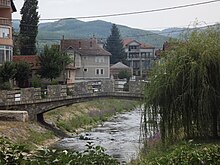Kosovo Pomoravlje
Kosovo Pomoravlje
| |
|---|---|
Valley | |
| Etymology: From the Binačka Morava river | |
| Kosovo Pomoravlje, in eastern Kosovo Kosovo Pomoravlje, in eastern Kosovo | |
| Country | Kosovo |

Kosovo Pomoravlje (Albanian: Lugina e Moravës Binçës; Serbian: Косово Поморавље) is a valley in Kosovo, in the southern part of the District of Gjilan surrounding the Binačka Morava river. It stretches eastward to the Preševo valley in southern Serbia. The mountains in this region, rising to an altitude of 1,000–1,200 metres (3,300–3,900 ft), border the Skopska Crna Gora region in neighboring Macedonia north of Skopje.[1] Gjilan, Kosovska Kamenica, Novo Brdo and Vitina are municipalities in Kosovo Pomoravlje. The region gives its name to the disputed Serbian Kosovo Pomoravlje District. It is known for recording the lowest temperature in Kosovo: −32.5 °C (−26.5 °F), on 25 January 1963.[2]
Location
Kosovo Pomoravlje District was a district of Serbia until 1999. After the United Nations Interim Administration Mission in Kosovo took control in 1999, it became the District of Gjilan. Pomoravlje is about 50 kilometres (31 mi) long and 15 kilometres (9.3 mi) wide. It is bordered by the Skopska Crna Gora mountains in the south and the Goljak in the north, and borders Kosovo field in the west. On the east, it borders the Morava Valley. The region's largest cities are Gjilan and Bujanovac.
Name

The region is known as Kosovsko Pomoravlje (Косовско Поморавље, "Morava Valley of Kosovo") in Serbian and as Lugina e Anamoraves Binçes ("Valley of Binačka Morava") in Albanian. Its name is derived from the Binačka Morava river, which flows through northern Macedonia, eastern Kosovo and southern Serbia as part of the Great Morava river system.
History
Herodotus wrote about the region in the mid-fifth century BC.[3] The first mention of Gjilan was during the 16th century. The area, with a population of 217,726, has its seat there. With the rest of Kosovo, it was transferred to United Nations administration. In 2000, the UN renamed the district to the District of Gjilan as part of a series of reforms. The Morava Valley is the hilly countryside of southeastern Kosovo south of Gjilan and the Morava e Binces River. It stretches eastward to the Presheva (Presevo) valley in southern Serbia.
Geography

The region includes part of the valley and the Karadak and Koznik mountains. Gjilan has six municipalities and 287 smaller settlements.[4] The spa in Klokot has several thermal springs valued for their medicinal qualities.[5]
Climate
At an altitude of 410 metres (1,350 ft) above sea level, the region has a continental climate with light winds (usually from the northeast). Rainfall is light, and winter often brings snow from the west; northern and western winds tend to bring rain.
The region's average annual temperature is 10.6 °C (51.1 °F). January's average is −0.9 °C (30.4 °F), and July's is 20.7 °C (69.3 °F).[6]

Hydrography

Tributaries of the Morava river system include the Karadak and Lăpușnicel Rivers. The Presevo Valley is a corridor between the Morava and Vardar valleys,[7] and the Morava valley's wetlands are home to many species of birds.[8]
Tranportation
Rail traffic passes through the Binces Valley near the Morava River tributaries.[citation needed]
See also
Notes and references
- Notes
| a. | ^ Template:Kosovo-note |
- References
- ^ Robert Elsie (15 November 2010). Historical Dictionary of Kosovo. Scarecrow Press. pp. 29–. ISBN 978-0-8108-7483-1.
- ^ in Gnjilane - AccuWeather Forecast for Gjilan Kosovo
- ^ id = 59143 # sthash.06WuRsWl.nv83BZNw.dpuf a compact Illyrian population Muhammad Bala published 9:05
- ^ Академик Божидар Видоески, Говорот на Скопска Црногорија: МЈ, 1954, V, 1, стр.1-30; 2, стр. 109-196: 2 к
- ^ "Komunat në rajonin e Gjilanit".
- ^ Dr.Albanien poblisher Riza Çavolli: Geography Regional in Kosovo:,publisher ETMMK, Prishtina, 1997.
- ^ Water separator Presevo Valley
- ^ ( IBA - International Bird Areas )
Bibliography
- * English: "History Kosovo Anamorava"Elsie, Robert (2010). A Biographical Dictionary of Albanian History (History Kosovo Anamorava. London: I.B.Tauris & Co. Ltd. p. 29. ISBN 978-1-78076-431-3. Retrieved 2015.
{{cite book}}: Check date values in:|accessdate=(help) - * ["А. Урошевић:"Гњилане. — Гласник Географског друштва, св. ХУП. Београд, 1931] Error: {{Lang-xx}}: text has italic markup (help)
- * ["А. Урошевић:Горња Морава и Изморник, Насеља и порекло становништва, књ. 28, Београд 1935] Error: {{Lang-xx}}: text has italic markup (help)
- * [[[Urošević|Anatasije Uroševic]] Gornja Morava i Izmornik] Error: {{Lang-xx}}: text has italic markup (help), Jedinnstvo.Priština 1993.(news-edicion)
- * ["Dr. Riza Çavolli,Geography Regional in Kosovo"] Error: {{Lang-xx}}: text has italic markup (help), publisher ETMMK, Prishtina, 1997.
- * Serbian: Srpski etnografski zbornik, VI "Skopska Crna Gora", Srpski etnografski zbornik, VI, Belgrade, 1905
